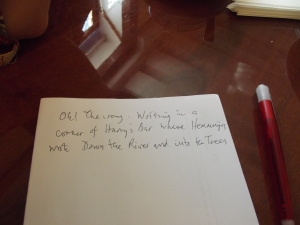Oh the irony! I am scribbling the draft of a blog on snatched hotel stationery; at a corner table in Harry’s Bar where Hemingway wrote Across the River and into the Trees. It is humbling. Papa himself always sat at the heavy oak corner table. The panel walls are more English than Italian. I press my cheek to the warm wood and I detect a waft of his ghostly breath. It smells of Prosecco and a fresh peach Bellini, it smells of Aperol and gunpowder.
 The barman is dressed in an art deco period white dinner jacket and black bow tie. It is 10.30am and far too early to be dressed this way. He serves us rough, broken almond shortbread and the best coffee we have had in two days. Without speaking my wife hands me more paper as I furiously write. It is like she is feeding the furnace of a steam locomotive.
The barman is dressed in an art deco period white dinner jacket and black bow tie. It is 10.30am and far too early to be dressed this way. He serves us rough, broken almond shortbread and the best coffee we have had in two days. Without speaking my wife hands me more paper as I furiously write. It is like she is feeding the furnace of a steam locomotive.
Days ago the doctor confirmed I was diabetic. The unwelcome but inevitable family inheritance has come home to roost at my 50th birthday. I picture my father: confused and lengthening vacancies in between insulin injections. I think on my sister’s half amputated foot. Her organs burned out and propped in her coffin at the age of 47. I think on my maternal grandmother; sweetened blood bursting the walls of her 57 year old heart. Their genes half century ticking like a time bomb deep in my bones.
Ernest knew. Hemochromatosis. His father had it. Oinbones showed the same symptomatic signs. He didn’t wait around. Heavy drink and see the world until the small hours of the night when he swallowed that shotgun. He knew how the story ended because he wrote it himself.
And in this bar: Harry’s Bar, dear readers, Hemingway wrote a novel about the ages of man. He wrote about our creeping greyness and thickening blood and the lessons we learned as we think back on our youth. He wrote about seemingly meaningless acts 30 years prior that take on new meaning and symbolism as we ponder them from the vantage point of age.
Once I knew a Venetian. She was the only one I ever met. 1983: the communal payphone in the university dorm rung for me. A halting Italian accent on the other end is Paola, my roommate’s legendary friend. We call him Jarhead as he is an army brat and has lived all over the world. Memory does not afford me the story of how they met; no doubt at some sunny Mediterranean military base. Jarhead had spoken of the girl he had met and her promise to one day show up on his doorstep in America. Now she had made good. She is at the Port Authority bus station in the city. She had made the long trip alone; across the sea from Venice. The army brat does not know. We entice him into the car with some concocted tale of an emergency situation in the city.
Paola surprised Jarhead. His face was consistently stone and never betrayed by emotion. He cracked that night.
Paola- petite and exotic with the soul of an artist stayed for weeks. I was painting a mural on the wall outside our dorm at the time: a screaming white mask with heavy dark eyes. One night, Paola deliberately painted the sole of her right foot with the remnants from the black can and pressed the print on the wall. There it stayed for ever; or at least through 1983, reminding us that she had passed through.
And now, thirty years on, what do I remember of that dorm room? The aging lazy boy recliner we had rescued from some vacant lot, the mural outside the door and Paola’s footprint on the wall.
And now, thirty years on, I was in Paola’s city, in Pound and Maughan’s bar, at Hemingway’s table.
An elderly American tourist shuffles past the door of Harry’s bar; white Reeboks and a baseball cap with the name of a battleship on it, “Bridge of Sighs. Not size. It’s SIGHS . You know- exasperated”
The skin of my face seems to be collapsing and collecting in my vast double chin in every photo that I review on our camera.
My wife laughs as I tell her, “ Mr Pineapple would like the Bridge of Sighs, he is naturally exasperated”. The elderly American tourists shuffle onto the Ponte della Paglia in white Reeboks and jostling to have their photo taken. Bridge of Sighs: the prisoners last view of the sea and sky before descending into the darkness of prison. How ironic thousands turn to looks at it, their backs to the sea and sky every moment since.
My feet are swollen. We walk and get lost. We stop for a coffee and get lost again. There are no cars to watch out for. The last of the cars are abandoned on the end of the long bridge Mussolini built to the mainland. Boats are the default setting for transport. Boats and feet. I scan the lapping canal water at the base of crumbling facades. I am looking for Paola’s left footprint on the wall.
 The plague ravished this city. It did it time and time again between the in the 14th and 17th centuries. Half the population would eventually succumb. Venice, it seems, has never recovered from the shock and every few meters there is a reminder of the tragic past and frailty of life. Every other shop window contains the mask of a plague doctor: black shrouded and with a long hollow beaked mask. 400 years ago the beak would be filled with herbs as a misguided science against the disease.
The plague ravished this city. It did it time and time again between the in the 14th and 17th centuries. Half the population would eventually succumb. Venice, it seems, has never recovered from the shock and every few meters there is a reminder of the tragic past and frailty of life. Every other shop window contains the mask of a plague doctor: black shrouded and with a long hollow beaked mask. 400 years ago the beak would be filled with herbs as a misguided science against the disease.
The city is stunningly beautiful. Built on pines driven into the mud 1600 years ago and now long petrified; the medieval homes of wealthy merchant survived while the rest of Europe burned and burned again. The crumbling plaster falls from the facades, wooden bare shutters drawn throughout the day. It is the aging beauty of Sophia Loren. Weathered and lived in, radiant and timeless.
Look closer: skulls are chiselled and sculpted into the walls. Stray cats are held in high regard. They keep the rats at bay which rules this city by night. Despite the reputation I have yet to see one and it disappoints.
We have lunch in a rough eatery in the Rialto market. I have Pasta Pescadore. I am Col Kurtz. Sell the house, sell the kids. I am never coming home.
I am reading a guide to Venice’s 400+ bridges. I coax my wife on the long walk to Ponte Delle Tette. “This I have to see,” I tell her as I relay the story of how 15th Century prostitutes would stand topless on the bridge or on nearby balconies. It seems this was a quality assurance exercise. Mrs Head reluctantly poses on the bridge in a more dignified and modest pose.
Our hotel bed is positioned facing the window, not the telly. I like it that way. A switch to the side opens the electric shutter and the lagoon is in front of us. A day of boats on shifting water remains in my inner ear and the large bed rocks with my lingering equilibrium. I shut my eyes and my sea legs wobble.
My wife is silently reading a guide to Venice Bridges. She tells me the story of the Ponte Dei Pugni: the Bridge of Fists. In the 17th Century fights on the bridge were common place and an accepted means of settling disputes. “There is a marble footprint embedded in the stone of the bridge,” she reads aloud, “to mark the spot where the fighters stood at the start of a bout.”
 And so it was. I scuffed the bottom of my walking shoes, my swollen feet on the marble footprint. I pushed off of the spot with the same foot my sister had half amputated. I was a fighter. I am a fighter. I pushed off from the footprint and shadow box on the bridge. I will not succumb like Ernest did. I can change my destiny.
And so it was. I scuffed the bottom of my walking shoes, my swollen feet on the marble footprint. I pushed off of the spot with the same foot my sister had half amputated. I was a fighter. I am a fighter. I pushed off from the footprint and shadow box on the bridge. I will not succumb like Ernest did. I can change my destiny.
Paola’s footprint now forever linked on the Bridge of Fists.
I thumb through Hemingway’s Across the River and Into the Trees:
‘Tell me some true things about fighting.’
‘Tell me you love me.’
‘I love you,’ the girl said. ‘You can publish it in the Gazzettino if you like. I love your hard, flat body and your strange eyes that frighten me when they become wicked. I love your hand and all the other wounded places.’
Keep the Faith,
The Head





Missing your blog entries. Hope you write something soon. Have a wonderful weekend!